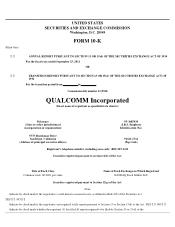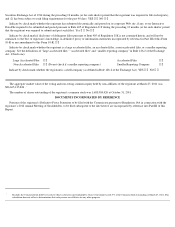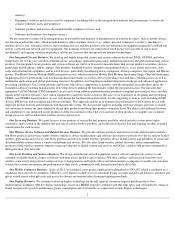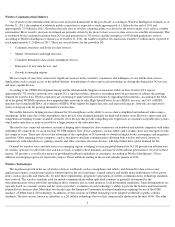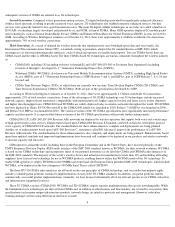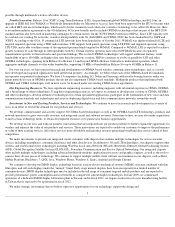Qualcomm 2011 Annual Report Download - page 10
Download and view the complete annual report
Please find page 10 of the 2011 Qualcomm annual report below. You can navigate through the pages in the report by either clicking on the pages listed below, or by using the keyword search tool below to find specific information within the annual report.
possible through multimode wireless subscriber devices.
Fourth Generation. Release 10 of 3GPP’s Long Term Evolution (LTE), the predominant global OFDM technology, and 802.16m, an
upgrade of IEEE 802.16e (WiMAX or Worldwide Interoperability for Microwave Access), have both been approved by the ITU to become what
are called IMT-Advanced technologies, which used to be the commonly used criteria for a wireless technology to be called 4G. However, there
is no uniform industry agreement on the 4G definition; 4G is now broadly used to include OFDMA technologies that are part of the IMT-2000
standard and has also been used in marketing campaigns by certain carriers for the 3G WCDMA evolution to HSPA+. Since LTE typically will
be overlaid over existing 3G networks, seamless interoperability with 3G (both HSPA and CDMA 2000) has been standardized by 3GPP and
3GPP2. According to the GSA, 35 commercial LTE networks have been launched as of October 2011. WiMAX was deployed ahead of LTE and
targeted unpaired spectrum using a TDD radio interface. LTE supports both paired spectrum, using LTE FDD, and unpaired spectrum, using
LTE TDD, and is able to address many of the unpaired spectrum bands targeted by WiMAX. Compared to WiMAX, LTE is expected to achieve
greater economy of scale through its interoperability with 3G. Certain wireless operators have selected WiMAX because of regulatory
considerations specific to their networks and spectrum holdings. The evolved OFDMA technologies will support additional features, wider
bandwidths of up to 100 MHz, and higher data rates than the previous versions. HSPA+ continues to evolve in parallel to LTE and other
OFDMA technologies, spanning from Release 8 to Release 11 and beyond. HSPA+ Release 8 introduces multicarrier operation, which
aggregates multiple channels to offer wider bandwidths, supporting 10 MHz of bandwidth in Release 8 to up to 40 MHz in Release 11.
For over ten years, we have pursued research and development of OFDMA-based wireless communication technologies, and, as a result,
have developed and acquired significant related intellectual property. Accordingly, we believe that each of the OFDMA-based 4G standards
incorporates our patented technologies. We have 13 companies (including LG, Nokia and Samsung) with royalty-bearing licenses under our
patent portfolio for use in OFDMA products that do not also implement CDMA-based standards. Multimode products that implement both
OFDMA and CDMA technologies will, in most cases, be licensed under our existing CDMA license agreements.
Our Engineering Resources. We have significant engineering resources, including engineers with substantial expertise in CDMA, OFDMA
and a broad range of other technologies. Using these engineering resources, we expect to continue to develop new versions of CDMA, OFDMA
and other technologies, develop alternative technologies for certain specialized applications, participate in the formulation of new voice and data
communication standards and technologies and assist in deploying digital voice and data communications networks around the world.
Investments in New and Existing Products, Services and Technologies. We continue to invest in research and development in a variety of
ways in an effort to extend the demand for our products and services.
We develop, commercialize and actively support 3G CDMA-based technologies as well as the OFDMA-
based LTE technology, products and
network operations to grow our royalty revenues and integrated circuit and software revenues. From time to time, we may also make acquisitions
to meet certain technology needs, to obtain development resources or to pursue new business opportunities.
We develop on our own, and with our partners, innovations that are integrated into our product portfolio to further expand the opportunity for
wireless and enhance the value of our products and services. These innovations are expected to enable our customers to improve the performance
or value of their existing services, offer these services more affordably and introduce revenue-generating broadband data services ahead of their
competition.
We make investments to provide our integrated circuit customers with chipsets that combine multiple technologies for use in consumer
devices, including smartphones, consumer electronics and other data devices. In addition to 3G and LTE technologies, our chipsets support other
wireless and wired connectivity technologies including Wireless Local Area Network (WLAN), Bluetooth, Ethernet, Global Positioning System
(GPS), Global Navigation Satellite System (GLONASS), Powerline Communication and Passive Optical Networking. Our integrated chipsets
often include multiple technologies, including advanced multimode modems, application processors and graphics engines, as well as the tools to
connect these diverse pieces of technology. We continue to support multiple mobile client software environments in our chipsets, such as Brew
Mobile Platform, Blackberry 7, QNX, Java, Windows Phone, Windows 8, Linux, Android and Google Chrome.
We continue to develop our IMOD display technology based on a micro-electro-mechanical-systems (MEMS) structure combined with thin
film optics and sell such displays under the “mirasol” brand. Early-stage mirasol displays have been incorporated in a limited number of
consumer devices. IMOD display technologies may be included in the full range of consumer-targeted mobile products and are expected to
provide performance, power consumption and cost benefits as compared to current display technologies. In June 2009, we commenced
operations of a dedicated IMOD display fabrication plant in Taiwan, and in fiscal 2011, we began construction of a new manufacturing facility
in Taiwan that is expected to be operational in fiscal 2012.
We make strategic investments that we believe open new opportunities for our technology, support the design and
5


